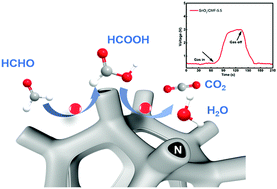Rational design and in situ growth of SnO2/CMF composites: insightful understanding of the formaldehyde gas sensing mechanism and enhanced gas sensing properties
Abstract
In this study, melamine foam (MF) and tin dioxide composites were prepared by an in situ growth method and subsequent treatment under a mild hydrothermal environment. The morphology, structure and sensing properties of these composites were studied in detail. The results show that SnO2 nanoparticles can grow well on the carbonized melamine foam (CMF) skeleton through a facile hydrothermal reaction, resulting in a stable three-dimensional (3D) porous hierarchical structure. The morphologies of these composites can be controlled accurately by adjusting the amount of SnCl2 precursor. It is found that the 3D hierarchical porous composite has better gas sensitivity and selectivity to HCHO gas than the pristine SnO2. The response of the optimized composite (the amount of the SnCl2 is 5.5 mmol) to 5 ppm HCHO gas can reach 30.0 with a LOD of below 1 ppm at an operating temperature of 120 °C. The detection of HCHO sensing products on the surface of the composite was studied by in situ infrared spectroscopy. It revealed that the intermediate product formic acid plays a key role in HCHO sensing. Meanwhile, CMF with a unique hierarchical structure and good conductivity is responsible for the enhanced gas sensing properties. In consideration of the flexibility of melamine foam, the composite has a good potential in miniaturized and wearable HCHO sensors.



 Please wait while we load your content...
Please wait while we load your content...